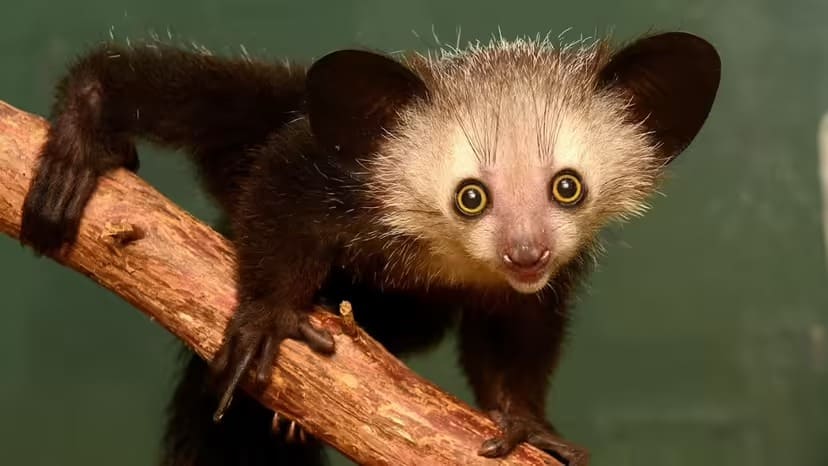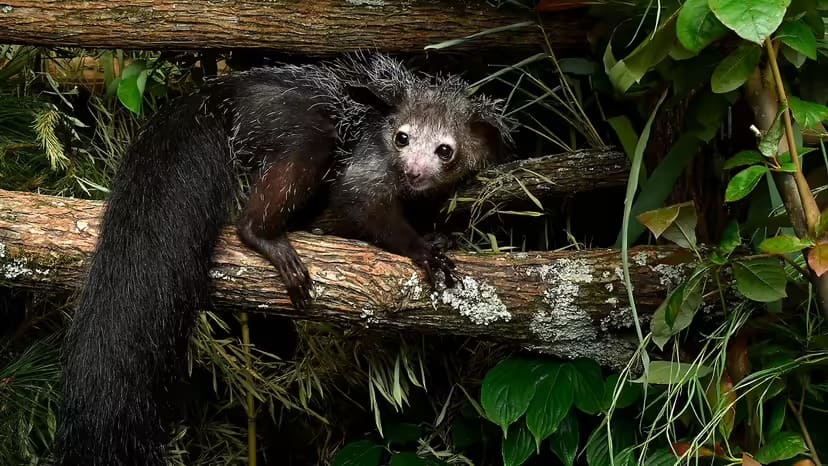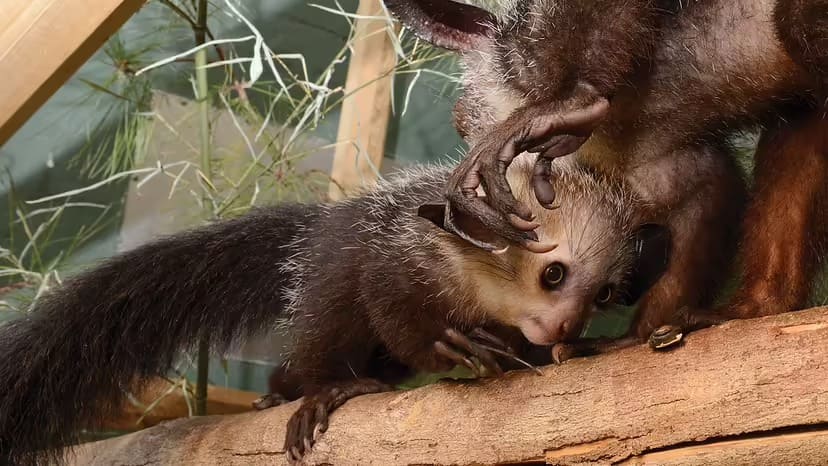Common name: Aye-aye
Scientific name: Daubentonia madagascariensis
Order: Primates → Strepsirrhines (lemur lineage)
Size: Body 12–16 in (30–40 cm); tail 18–22 in (45–55 cm); 5–6 lb (2.3–2.7 kg)
Activity: Nocturnal, arboreal
Range: Madagascar (various lowland to mid-elevation forests, incl. secondary and agro-forest mosaics)
IUCN status: Endangered (among the world’s most threatened primates)

Big amber eyes give a “perpetually surprised” look—perfect for night vision.
A huge, fluffy tail longer than the body acts like a counterbalance in the canopy.
Among primates, the aye-aye is the largest nocturnal species—small overall, but a heavyweight after dark.
The aye-aye’s triangular ears (enormous for a primate) carry ridges that tune incoming sound.
Paired with fingertip tapping (see below), those ears detect hollow spaces and moving larvae inside wood.

Unlike other lemurs with a “toothcomb,” aye-ayes have ever-growing incisors—one reason they were once misclassified as rodents.
Result: a built-in chisel for bark, nuts, and tough wood. Chips, cracks, or wear aren’t a long-term problem—the teeth keep growing.
Each hand ends in slender, curved claws (not flat nails) that hook, pry, and hang.
Fully extended, the fingers can reach ~41% of forearm length, so aye-ayes hold them up when walking on the ground—hence that quirky gait.
A newly described pseudothumb (bone + cartilage nub) on the wrist boosts grip and suspension—handy in cluttered branches.

The ultra-thin middle finger rotates almost like a human shoulder.
It’s a precision tool that taps, probes, hooks, and fishes larvae out of tunnels that teeth have opened.
Aye-ayes are the only known primates to use percussive foraging—a tap-listen-dig-hook sequence that fills Madagascar’s woodpecker-like niche (the island lacks true woodpeckers).
How it works
Tap rapidly (up to ~8 taps/sec) along trunks and branches.
Listen with those hyper-sensitive ears for acoustic cues (hollows, larvae).
Chisel through wood with ever-growing incisors.
Hook out grubs using the flexible middle finger’s claw.
This combo lets the aye-aye exploit hidden, high-calorie prey few other species can reach.
Aye-ayes are loosely social but often forage alone, spacing out to cover more ground and reunite later.
Female territoriality is common—resident females may drive off unfamiliar females; male ranges tend to overlap more.
Communication blends scent marks with a surprisingly rich call repertoire (see below).
A recently extinct relative, the giant aye-aye, likely survived within the last ~1,000 years.
Judging by massive limb bones, it may have weighed 2.5–5× a modern aye-aye (to ~11+ kg / 25 lb), probably specializing in extremely hard foods.
Screams in aggression, whimpers during feeding disputes, a short “tiss” when confronting other lemurs, and an urgent “hai-hai” when fleeing—which may have inspired the common name “aye-aye.”
In parts of Madagascar, aye-ayes are considered bad omens; folklore claims a pointed finger can foretell death—myths that can lead to persecution.
In care, aye-ayes are highly trainable and engage well with positive-reinforcement behaviors (e.g., voluntary ultrasounds and blood draws), improving veterinary welfare.
The species’ bad rap + deforestation helped land it on lists of the 25 most endangered primates.
Habitats: Primary and secondary forests, flooded forest edges, and agro-forest mosaics; they rely on large trees and deadwood (standing snags) for foraging.
Diet: Wood-boring larvae and beetles, plus nuts, fruits, nectar—a flexible menu with high protein “jackpots.”
Ecosystem value: Reduces wood-borer loads (forest health) and may aid seed dispersal where fruit is targeted.
Key threats
Forest loss and fragmentation (logging, fire, agriculture, infrastructure).
Persecution driven by negative folklore.
Illegal take (curiosity, pets, trophies) in some areas.
Effective actions
Protect and connect: expand reserves, restore corridors, keep snags/woody debris that support percussive foraging.
Community co-management and benefit-sharing ecotourism to flip incentives from fear to stewardship.
Myth-busting outreach: culturally sensitive education to reduce persecution.
Night surveys & monitoring: acoustic recorders, camera traps, and photo-ID to track trends.
Safeguard big trees and mixed-age stands; avoid “over-cleaning” deadwood.
Why can the middle finger rotate so much?
Specialized joints, tendons, and ligaments create near-shoulder-like rotation, letting the finger probe, pivot, and hook in tight insect tunnels.
Do aye-ayes damage crops?
They primarily target insects and hard seeds. Occasional orchard visits can be mitigated with tree-line buffers, night patrol patterns, and non-lethal deterrents.
Why keep deadwood and snags?
They’re insect factories—and acoustic targets for tapping. Removing them strips away the aye-aye’s core feeding resource.
Can captive aye-ayes be reintroduced?
Only with rigorous health screening, behavioral readiness, habitat capacity, and conflict-risk assessments. Even then, habitat protection remains the priority.
animal tags: aye aye
We created this article in conjunction with AI technology, then made sure it was fact-checked and edited by a Animals Top editor.